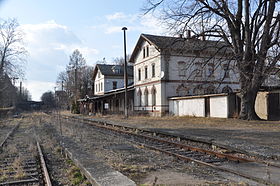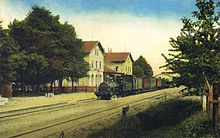Lommatzsch train station
| Lommatzsch | |
|---|---|
|
Station building, track side
|
|
| Data | |
| Operating point type | former train station |
| Location in the network | former connection station |
| Platform tracks | 2 |
| abbreviation | DLOM |
| opening | April 5, 1877 |
| location | |
| City / municipality | Lommatzsch |
| country | Saxony |
| Country | Germany |
| Coordinates | 51 ° 11 ′ 34 " N , 13 ° 18 ′ 28" E |
| Railway lines | |
|
|
| Railway stations and stops in Saxony | |
The Lommatzsch station was a place of business of the railway line Riesa-Nossen and the former narrow-gauge railway Wilsdruff Gärtitz in the municipality of the city Lommatzsch in Saxony. As a gauge changing station , it used to have extensive passenger and freight traffic, especially during the beet campaign , the track systems on both gauges were heavily used. Narrow-gauge operation ended on October 28, 1972, and since 1998 no trains have been running on the Riesa – Nossen railway line.
history
Lommatzsch station was built on April 5, 1877 with the opening of the Riesa – Nossen railway line. At that time the station consisted of the station building , an economic and administrative room , a goods shed , a fountain, the free depot and a small, separate locomotive shed at the later station exit towards Nossen . As a station track, it had two platform tracks and then a four- track group of tracks for handling freight traffic. The entrance to the train station from Riesa was shaped by a bridge over the tracks that can still be seen today. A used turntable from Riesa was installed in front of the locomotive shed . There was also a small turntable in front of the goods shed. For cargo handling two were Niederlagsplätze created.
With the opening of the Lommatzsch – Nossen section around 1880, there was no longer any need for the locomotive shed. It was demolished again in 1883. The turntable was left because there was still a need to turn the locomotives. Notable changes from this time on were the construction of several goods sheds instead of the depots. The existing goods shed was expanded with an extension. In addition, a weighbridge and a load gauge were installed on the track in front of it . A large head and side loading ramp was built between the railway maintenance building and the goods shed. Backup Technically, the station was with two guards signal boxes of type Thomass equipped.
When the narrow-gauge railway Wilsdruff-Gärtitz reached Lommatzsch station on December 1, 1909 , this was the beginning of further extensive renovations. The standard gauge systems got a siding to the local Carlswerke and a small locomotive shed at the entrance to the station from Riesa with a turntable with a diameter of 18 m. Since the radius of the siding was too small, the storage shed could not be used by the small locomotive , but was used by the SKL of the station. Otherwise, the tracks on the standard gauge remained essentially unchanged.
The narrow-gauge railway reached the station at the entrance to the station from Nossen. It crossed what would later become Bahnhofsstraße and ended on the other side of the street in a three- track group of tracks . A water house, which still exists, was built for the Kleinbahn next to Bahnhofstrasse. In addition, the narrow-gauge railway had a siding in front of the goods shed as well as to a loading ramp and trolley pit located at the entry area towards Nossen .
In the 1930s, the narrow-gauge systems were extensively expanded. The group of tracks in front of Bahnhofstrasse was given two additional sidings, and another track led across Bahnhofstrasse to the once again enlarged goods shed. In addition to the trolley pit, a driveway was built into the front building of the smaller goods sheds, as well as a reloading area between the wagons of the various gauges and a loading ramp for narrow-gauge vehicles onto standard-gauge vehicles . In the eastern part of the station, behind the Bahnhofstrasse, the two-tier engine shed with a turntable was set up, which was a siding. The standard gauge area received an additional track next to the loading road with a stationary gantry crane . After this time, the track layout of the station hardly changed. The turntable in the standard gauge area, which was used for turning for hinged-lid cars with jamming openings, was removed in the 1970s.
The station was heavily used during the beet campaign , with sugar beet loading on the narrow-gauge railway for the sugar factory in Döbeln from 1911 to 1968 . After that, the beet loading was on the loading road and next to the goods shed. Other goods, such as deliveries of beech logs, were among the most common goods. The last goods that reached Lommatzsch station were coal deliveries.
In 1981 the previous mechanical interlockings were replaced by an electromechanical interlocking with Hl light signals .
On June 1, 2014, the Nossen-Riesaer Eisenbahn-Compagnie acquired the listed station building from Deutsche Bahn. This is justified in particular with the traffic control located on the ground floor, which is required for any resumption of railway operations to Lommatzsch. In addition, in connection with the planned establishment of a trolley from Lommatzsch to Starbach , catering is to be set up again in the station building.
Platforms
In the standard gauge area, the station had two platform tracks with two platforms until the end. The narrow-gauge area had the usual station facilities in the track area.
traffic
The routes via Lommatzsch already showed successful developments in the first few years of their existence. Both passenger and freight traffic increased steadily. The rural population first used the new railway, but soon rush hour traffic to the industrial center of Riesa developed . There was soon a possibility of transit traffic to Prussia or Bohemia .
In 1880 292 passenger trains and 2,640 mixed trains ran in the direction of Riesa. From the opening, 468 mixed trains ran on the section towards Nossen.
There is information about the traffic performance in 1890; 74,967 people and 26,042 t of goods were transported. On average in Saxony, this was a good midfield position.
In 1899 there was a continuous train connection from Riesa to Moldova . Five pairs of trains ran on the route. During the war years of the First World War , five pairs of passenger trains ran daily on the Riesa – Nossen railway line. In the winter timetable 1918/1919, the transport performance was four pairs of trains.
In 1914, five pairs of passenger trains ran on the narrow-gauge railway between Garsebach and Lommatzsch, and three pairs of trains at the same time between Döbeln and Lommatzsch.
In 1925 four pairs of passenger trains ran between Garsebach and Lommatzsch, and three pairs of trains ran between Döbeln and Lommatzsch at the same time. In 1939 there were again four pairs of passenger trains between Garsebach and Lommatzsch, and three pairs of trains at the same time between Döbeln and Lommatzsch.
After the Second World War, the traffic situation did not change significantly; the course book 1950/1951 provided four pairs of passenger trains for the connection between Garsebach and Lommatzsch, and three pairs of trains at the same time between Döbeln and Lommatzsch.
This traffic behavior remained the same in 1963. Only two trains were used between Döbeln and Lommatzsch. In the 1972/1973 timetable, the traffic between Lommatzsch and Löthain was still three pairs of trains. The traffic to Döbeln was already stopped.
Engine shed
Locomotives were only at home in Lommatzsch on the narrow-gauge railway. Only when the Riesa – Lommatzsch line opened in 1877 was a small engine shed in the standard gauge area, which was demolished again in 1883. Later there was only one small locomotive shed on the standard gauge side.
The locomotive shed on the narrow-gauge side had two levels. It belonged to the Mügeln railway depot as a locomotive deployment site . Locomotives of the Saxon type IV K were always at home here . After the closure of the line to Döbeln and the section from Löthain to Garsebach, it was used to service the rest of the line from Löthain to Lommatzsch without a connection to the remaining network. The engine shed has been a listed building since 2000 and is still there.
literature
- Reiner Scheffler, Peter Wunderwald: The Riesa-Nossen railway line - a journey through time through the 125-year history of one of the most interesting railway lines in central Saxony ; Wilsdruffer Railway Books 2004
Web links
- Website on the Kleinbahn Wilsdruff-Gärtitz at www.sachsenschiene.net
- Website on the Riesa-Nossen railway line at www.sachsenschiene.net
- Pictures of the former narrow-gauge train station Lommatzsch on www.stilllege.de
- Photo collection of images of the former Mertitz - Lommatzsch narrow-gauge railway at www.stilllege.de
- Photo collection of pictures of the narrow-gauge train station Lommatzsch on www.eisenbahnrelktionen.de
Individual evidence
- ↑ Reiner Scheffler, Peter Wunderwald: The Riesa-Nossen railway line - a journey through time through the 125-year history of one of the most interesting railway lines in central Saxony ; Wilsdruffer Bahnbücher 2004, track plan on page 88 above
- ^ Photographic representation of the course of the small train from Mertitz Gabelstelle to Lommatzsch on www.stilllege.de
- ↑ Photographic representation of the integration of the narrow-gauge railway in Lommatzsch station on www.sachsenschiene.net
- ↑ Photo of the preserved water house from 2015 on www.sachsenschiene.net
- ↑ Reiner Scheffler, Peter Wunderwald: The Riesa-Nossen railway line - a journey through time through the 125-year history of one of the most interesting railway lines in central Saxony ; Wilsdruffer Bahnbücher 2004, track plan page 88 center
- ^ Photograph of the locomotive shed from 2002 on www.sachsenschiene.net
- ↑ Reiner Scheffler, Peter Wunderwald: The Riesa-Nossen railway line - a journey through time through the 125-year history of one of the most interesting railway lines in central Saxony ; Wilsdruffer Bahnbücher 2004, track plan on page 88 below
- ↑ Current information on www.nre-compagnie.de
- ↑ Timetable of the trains between Garsebach and Lommatzsch at www.sachsenschiene.net
- ↑ Timetable of the trains between Döbeln and Lommatzsch on www.sachsenschiene.net
- ↑ Timetable of the trains between Garsebach and Lommatzsch 1925 on www.sachsenschiene.net
- ↑ Timetable of the trains between Döbeln and Lommatzsch 1925 on www.sachsenschiene.net
- ↑ Timetable of the trains between Garsebach and Lommatzsch 1951 on www.sachsenschiene.net
- ↑ Timetable of the trains between Döbeln and Lommatzsch 1950 on www.sachsenschiene.net
- ↑ Timetable of the trains between Garsebach and Lommatzsch 1963 on www.sachsenschiene.net
- ↑ Timetable of the trains between Döbeln and Lommatzsch 1963 on www.sachsenschiene.net
- ↑ Timetable of the trains between Löthain and Lommatzsch 1972/1973 on www.sachsenschiene.net




